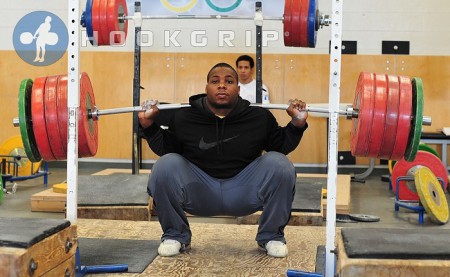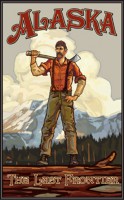PR Friday: Post PR’s and training updates to comments. Mingle. Have a good time.
Continuing Weekly Challenge: Movember Fundraising:
The 70’s Big Movember Network (including other countries) has raised $3,263 at the time of this writing. That’s purdy good, but we’re right after the halfway point in the month, and the goal this year was to raise $8,000. The approach this year was to ask as many of you to join the team as possible, and get as many donations as possible. It seems obvious, but there are about 30 members on the team who haven’t raised any money at all. Just ask your family and friends to donate $1 — literally one doll hair. If you accumulate $10 total, that will be neat. Especially if you other guys reading this join the team and raise your own $10. This cancer stuff can effect all of us; an old friend recently caught some early stages of cancer. Raising this money isn’t self serving; it’ll help people like him. Thank you for your time or effort in this fundraising.
Weekly Recap: Sunday was Veteran’s Day, and thank you to anyone generous enough to donate two bucks to two different veteran charities; showing vets that you are willing to take action for them means more than your words. On Monday Jacob Cloud posted about the women who competed at the Longhorn Open. Tuesday we talked about two good posts from Glenn Pendlay about weightlifting programming. Wednesday we dug into some of the reasoning why Misha Koklyaev was unable to represent Russia in the Olympics for weightlifting.
I replied/answered to a few posts from last week’s Q&A.
Q&A
Connor on November 4, 2012 at 12:22 pm said:
Justin, I thought this might make an odd, yet informative question/post. It seems that I’ve run into a problem that every man runs into: the roids…not the steroids, but the hemorrhoids. I have them and they’re really fucking up my workout schedule man. I really don’t know what to do about them, so I guess I’m going to go see Dr. Jelly Fingers in a couple of days to see what he says because this shit is unbearable (pardon the pun).So these are my questions:
Does squatting and heavy lifting cause hemorrhoids? That’s what everyone keeps telling me and I deny it, but I really can’t attribute it to anything else. How should I go about my training until it gets healed? Squatting is pretty much out of the question when it gets irritated. Thanks for reading this man. I know it’s kind of a funny topic or whatever, but it’s serious man. I can’t, and won’t stop strength training, which is what I’m 90% sure the doctor will tell me to do. So what is your knowledge and experience on what to do in this situation?
Dear Connor,
Interesting yet probably relevant topic, indeed. Let me preface this with the fact that my hemorrhoids knowledge is limited; I haven’t had them more than half my life nor have I coached anyone that has had them. I did find this article and will point out a few things along with adding some other information.
Hemorrhoids are an enlarged vein in the anus, and they can distend outside of the body. Dealing with existing hemorrhoids includes:
– avoiding putting pressure into the lower abdomen when lifting (thereby pushing it in the bully or up into the closed throat)
– stay hydrated, eat healthy fats to soften the stool (to avoid irritating the hemorrhoids)
– don’t strain when pooping
– take a sitz bath
– don’t take over the counter anti-inflammatories
The article above points out that it’s still possible to train with hemorrhoids, but you obviously want to take care to not make them worse. In order to prevent hemorrhoids, I think the best thing you can do is progress into heavy lifting when you aren’t adapted to it. Irritating the blood vessels around the anus is the result of two possible things: a) putting excessive pressure in that region when lifting or b) increasing general blood pressure when you’re not adapted to it. To avoid putting pressure towards the B-hole, take a big breath, and then try to expel it through your throat and mouth, but close the epiglottis so that no air can move through your throat. When you do this, you’ll probably feel your abdominal muscles contract and pressure in your upper body increase. If you’re not used to this, be careful using it when you are actually lifting; it’s a bit different than merely taking a big breath and holding it.
Keep in mind that the adaptation to pressure increases will probably dictate forming or irritating hemorrhoids. The guy in the article above can squat and deadlift over 700 pounds without symptoms, but you may need to work to adapt to a work load near or at your max. Oh, and obviously don’t put large pressure stresses on them when they are flaring up.
zapata on November 9, 2012 at 1:42 pm said:
brb still waiting for Justin to answer a Q&A about fucking magnets, how do they work?
Dear zapata:
http://science.howstuffworks.com/magnet1.htm
patrick87 on November 9, 2012 at 4:55 pm said:
QUESTION: During weighted chins I’m noticing that my right shoulder/chest touches the bar considerably earlier than my left side. I’m only doing barbell excercises – no dumbbell or other one-sided lifting work – and always check that I’m in the middle of the bar. What does it mean and how do I counter this problem? Is it muscle
imbalance or is my posture screwed up?
Dear patrick87,
I can’t say for certain what the issue is without seeing it. The likely culprits are a lack of mobility or poor posture. You could also have some strength or musculature imbalances. I’d try and figure out which of these you think it is and deal with it appropriately. In the mean time, try to touch both shoulders at the same time (you may have to cue the opposite side to lead the way).
First rugby game ever last night. We won, absolutely dominating what has long been considered the best team in the league. And the coach declared me “man of the match.” I haven’t felt so proud in a long time.
QUESTION: I have heard that NSAIDs can cause damage to the intestinal lining and tax the liver, but let’s be real now, after the beating I took last night, fish oil and mobbing aren’t going to cut it for getting me back into playing condition within a week, and definitely not enough to get me ready to squat on Monday. I know from past experience that NSAIDs have helped me get rid of problems in two days that fish oil and mobbing hadn’t solved in weeks. Is there anything wrong with taking ibuprofen for a day or two for a quick fix? If not, what are my options for getting myself healed quickly?
Note: I eat (mostly) paleo (I include dairy and potatoes fairly regularly) and take tons of fish oil and vitamins, and drink lots of water. The areas that are most hurt right now are my right shoulder and both of my quads. Last time I had tissue bruised this badly it took two weeks to feel better. I don’t have that kind of time anymore. Any suggestions would be greatly appreciated.
Dear newgetelqueso,
A few things. First, let’s look at pseudodan’s response to you last week. He alluded to the fact that strength training “wasn’t paleo” and such. This is referring to the “paleo lifestyle” bullshit that people talk about (which pseudodan is against; I just wanted to rant about this). Paleo is just the nutrition thing, because anybody that is not brushing their teeth or squatting to shit (at home) is an idiot. Trying to avoid the “Neolithic lifestyle” is not only stupid as shit, but it’s hypocritical unless they are out in the woods and they’d still be using their neolithic knowledge they picked up before trying to devolve.
All that being said, potatoes are fine when following Paleo nutrition (I’ll talk more about stuff like this soon). pseudodan mentioned you should be weary of increasing fish oil, and I agree if you’re already taking 4 or 5 grams of it. Otherwise you could increase it to that. I agree with pseudodan that acute intakes of ibuprofen and such is okay. But, now that you’re a real athlete who is getting his body smashed, you need to start looking into advanced recovery techniques, particularly methods to reduce swelling as fast as possible like compression, elevation, ice (“Should you use ice?” and “How should we ice, then?“), contrast baths (they pulse the lymphatics system as a whole), and some basic movement with compression (depending on the advancement of the injury).
I have a question maybe for next weeks Q&A maybe its an easy reply. I have been rehabbing from back surgery with The diesel crew back rehab protocol, easy way to sum it up is lots of bird dog, planks, bridges, dumbell RDLs, band good mornings, anti latteral flexion and rotation work, along with hip and thorasic mobility.I have been doing good working out 7 days a week for a few weeks, 5 days a week for a few weeksand now I’m nearing the last few weeks of the program at 3 days a week before going back to regular barbell training 3 days a week. I’m excited to have come this farbut I’m still dealing with a good amount of back soreness. I understand that what I am doing is going to cause soreness since I am trying to over come the last year of my back being a mess and doing nothing physical for it, but I am wondering if there is any strategy to improving tissue quality in my low back to help speed this up. I have had sucess in other funky areas using foam rollers, soft balls, lacrosse ballsand other tricks but I’m unsure of safe ways to do the same in the low back. I don’t have 1 spot injury pain, just a general soreness and tightness that you would get from working out. I am overweight and have already gotten my diet and supplements under control, I’m sure that will help greatly as time goes on. I also take no pain medications. Any recovery advice for this area would be greatly appreciated.
Dear Shawn Zep,
 I think that your active approach to rehab is good, and don’t be afraid to continue it. If it doesn’t accomplish anything for a few weeks, then you will want to reconsider the approach. In general, I recommend that you stay active — especially because you say you’re overweight. If you aren’t walking daily, then I recommend that. In FIT, I talk about speed walking for 15 minutes several times a week, and this sounds like a good idea for you in addition to whatever rehab or lifting you may be doing (walking is also good rehab for the back).
I think that your active approach to rehab is good, and don’t be afraid to continue it. If it doesn’t accomplish anything for a few weeks, then you will want to reconsider the approach. In general, I recommend that you stay active — especially because you say you’re overweight. If you aren’t walking daily, then I recommend that. In FIT, I talk about speed walking for 15 minutes several times a week, and this sounds like a good idea for you in addition to whatever rehab or lifting you may be doing (walking is also good rehab for the back).
I’m a big fan of rotational exercises and lateral spine stuff, and it sounds like that is present in your routine. It may be a bit early to lift, so try to incorporate some basic calisthenics if you can (squatting, lunging, push-ups, pull-ups, etc.). When you do start lifting, start with very light weight (the bar) and keep your normal rehab stuff in. Standard rehab advice is: do a little, see how it responds, then do just slightly more next time if everything is fine.





